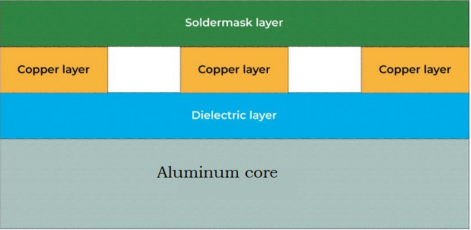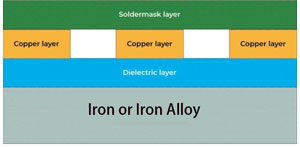What are the advantages of Metal Core Printed Circuit Boards?
What are the advantages of Metal Core Printed Circuit Boards?
1. Understand the types of metal bases used in MCPCB
Metal core PCB materials are mainly aluminum PCB, copper-based PCB, and iron-based PCB. However, aluminum is the most common one in the market, and it is usually used in the LED industry due to its price advantage.
The core (base) material of our common PCB is ordinary FR4/CEM1-3, while the metal core PCB (MCPCB) is a printed circuit board (PCB) with a metal base, which helps to dissipate heat. MCPCB is also called thermal PCB, insulated metal substrate (IMS), thermal cladding PCB. Metal materials are aluminum, copper and steel alloys.
2. Types of Metal Bases Used in MCPCB
Aluminum Core
Aluminum core PCB, also called aluminum PCB, has good heat transfer and heat dissipation capabilities and is relatively cheap; it is the most commonly used type of metal PCB in the LED industry. The characteristics of aluminum substrate MCPCB are divided into 3 parts as follows:
Features:
llAluminum thickness: 2mm to 8mm
llThermal conductivity: 5W/(mK) to 2.0W/(mK) (watts per meter Kelvin)
llCoefficient of thermal expansion: 23ppm/°C
llThermal conductivity: 80-90mm²/s
llBreakdown voltage:>3000V
lDielectric loss angle: 0.03
Structure:
(1) Circuit layer (copper layer)
This is the copper foil layer of the printed circuit, from 1.0 ounce to 8 ounces (35um-280um) Min.Trace/space5/5mil (127/127mm)
(2) Dielectric layer (insulating barrier)
If the raw materials have good prices and delivery time in China for the production of materials, we also have many customers choose BergquistThermal-clad and stretched board materials to strictly meet customer requirements to produce ALPCB.
(3) Substrate layer (metal layer)
There are 4 types of aluminum, 1001, 3001, 5052, 6063. If there is no such requirement, we use 5052 for high thermal conductivity (2.0 W/mk or higher), AL1001, AL3001 for 1.0 W/mk to 1.5 W/mk.

This is a single-layer Aluminum Core substrate structure.
Copper core PCB
Copper core PCB is a copper circuit layer PCB with a copper substrate insulation layer, also known as copper substrate PCB copper base PCB copper clad PCB. It can also be used in the LED field. Although copper core PCB and aluminum core PCB have similar characteristics and functions, there are still some differences between the two PCBs. For example, the difference in price and thermal conductivity.
Copper-based printed circuit boards are one of the most expensive metal substrates, and their thermal conductivity is many times better than that of aluminum and iron substrates. It is suitable for high-frequency circuits, high and low temperature change areas and precision occasions, communication equipment heat dissipation and architectural decoration industries.
Features:
Copper thickness: 35μm to 280μm
Thermal conductivity: The thermal conductivity of ordinary copper core PCB is 1W/mK to 9W/mK, while the thermal conductivity of copper core PCB with thermal isolation is 400W/mK.
Thermal expansion coefficient: 17ppm/°C, the thermal expansion coefficient of copper is about 17 ppm/°C, which is close to the thermal expansion coefficient of silicon chip (about 2.6 ppm/°C), reducing the impact of thermal stress on the circuit.
Thermal conductivity: 100-120
Density (g/cm³): 8.96
Structure:
Iron-based PCB
Iron-based printed circuit boards (PCBs), also known as metal core PCBs (MCPCBs), use iron as a substrate material to replace traditional FR4, providing enhanced heat dissipation and mechanical strength, especially in high-power applications.
Features:
Thermal conductivity: The thermal conductivity of iron-based PCBs is usually between 30-50 W/m·K, and the specific value depends on the composition of the iron-based material (such as pure iron or iron alloy) and the material of the insulating layer.
Thermal expansion coefficient: The thermal expansion coefficient of iron-based PCBs is about 11-12 ppm/°C, which is closer to the thermal expansion coefficient of silicon chips (about 2.6 ppm/°C) compared to the thermal expansion coefficient of copper (about 17 ppm/°C) and the thermal expansion coefficient of aluminum (about 23 ppm/°C). This low thermal expansion coefficient gives iron-based PCBs better dimensional stability in high temperature environments and reduces the impact of thermal stress on the circuit.

Thermal conductivity:
The thermal conductivity of iron-based PCBs is usually between 10-15 mm²/s, and the specific value depends on the thermal conductivity, density and specific heat capacity of the material.
Structure: Iron-based PCB consists of three layers: circuit layer (copper foil), insulation layer (such as modified epoxy resin) and metal base layer (iron or iron alloy). This structure makes it perform well in electronic devices with high power and high heat dissipation requirements.
The following table compares the parameters of the three metal cores:
parameter | Iron-based PCB | Aluminum PCB | Copper-based PCB |
Thermal conductivity (W/m·K) | 30-50 | 200 | 400 |
Coefficient of thermal expansion (ppm/°C) | 11-12 | 23 | 17 |
Thermal conductivity (mm²/s) | 10-15 | 80-90 | 100-120 |
3. Principle of heat conduction of metal core PCB:
Excessive heat accumulation in the circuit board can cause equipment failure. Electronic devices that generate a lot of heat cannot always be transferred from a hot component to a cooler component through direct contact. This method works well because heat always tries to transfer to any cooler object or medium.
4. Advantages of Metal Core PCB
Metal core PCB uses metal material as its base, which is used for the heat sink part of the circuit board. During the operation of the circuit board, heat is generated due to certain electronic components. The role of gold is to transfer heat from key circuit board components to less important areas, such as metal heat sink backplane or metal core. Therefore, different metal cores have different advantages, but these PCBs are suitable for thermal management. Whether it is iron-based PCB, aluminum-based PCB, or copper-based PCB, they all have excellent heat dissipation performance, can effectively conduct and dissipate heat, and are suitable for high-power devices such as LED lighting, automotive electronics, and industrial control equipment.
Iron-based PCB has high rigidity, can withstand external shock and vibration, has high mechanical strength, and can effectively shield external electromagnetic interference, improving the stability and reliability of the circuit. The dimensional change in high temperature environment is small, which is suitable for applications with high precision requirements. Although the thermal conductivity is lower than that of copper-based PCB and aluminum-based PCB, compared with aluminum-based and copper-based PCB, iron-based PCB has higher mechanical strength and magnetic conductivity. Iron still has advantages in specific application scenarios (such as occasions where magnetic conductivity or high mechanical strength is required).
The density of aluminum in aluminum-based PCb is low (about 2.7 g/cm³), which is suitable for weight-sensitive applications. Compared with copper-core PCB, aluminum-based PCB has lower manufacturing cost, mature manufacturing process, high reliability, and can be mass-produced. Aluminum-based PCB has certain rigidity and impact resistance, suitable for general industrial applications.
The thermal conductivity of copper-core PCB is better than that of aluminum and iron, up to 400 W/m·K, which is several times that of the former two. It can quickly conduct and dissipate heat and is suitable for high-power devices. Copper has excellent electrical conductivity and is suitable for high-frequency circuits and signal transmission. And like iron-based PCB, it has high rigidity and impact resistance, and can be used in harsh environments. The thermal expansion coefficient of copper is about 17 ppm/°C, which is close to the thermal expansion coefficient of silicon chips (about 2.6 ppm/°C), reducing the impact of thermal stress on the circuit. It has good electromagnetic shielding performance and can effectively reduce electromagnetic interference (EMI).
5. Disadvantages of metal core printed circuit boards.
Iron-based PCBs are difficult to manufacture and costly, and have relatively few market applications, mainly in high-end fields. They are heavy and have limited supply of large sizes. Copper-core PCBs are expensive and have complex manufacturing processes. They are heavy and not suitable for weight-sensitive applications. Aluminum-based PCBs have a high coefficient of thermal expansion and may produce thermal stress in high-precision applications. Their mechanical strength is not as good as copper-core PCBs and iron-based PCBs.
6. Production Process
Iron-based PCB:
Grinding:Surface treatment using 500# brushes.
Washing and Passivation: Cleaning the surface and performing passivation treatment to prevent oxidation.
Drying: Ensuring the substrate is dry to avoid issues in subsequent processes.
Copper-core PCB:
The manufacturing process of copper-core PCB is more complex and mainly includes the following steps:
Substrate Preparation: Selecting high-purity copper or copper alloy as the base material.
Insulation Layer Coating: Applying high thermal conductivity insulating material on the copper substrate.
Circuit Layer Fabrication: Forming circuit patterns on the copper foil through etching process.
Drilling and Surface Treatment: Drilling and completing surface treatments (such as gold plating, silver plating, etc.).
Testing and Inspection: Conducting electrical and thermal performance tests.
Aluminum-based PCB:
The manufacturing process of aluminum-based PCB is relatively mature and mainly includes the following steps:
Substrate Preparation: Selecting high-purity aluminum or aluminum alloy as the base material.
Insulation Layer Coating: Applying high thermal conductivity insulating material on the aluminum substrate.
Circuit Layer Fabrication: Forming circuit patterns on the copper foil through etching process.
Drilling and Surface Treatment: Drilling and completing surface treatments (such as gold plating, silver plating, etc.).
Testing and Inspection:Conducting electrical and thermal performance tests.
7. Applications of Metal-core PCB
Iron-based PCBs can be used in some high-performance floppy disk drives, brushless DC motors for computers, motors for fully automatic cameras, high-end motors and motor metal heat dissipation substrates, as well as some military cutting-edge technology products.
Both copper-core PCBs and aluminum-based PCBs can be used in high-power LED lamps, providing efficient heat dissipation performance. In automotive electronics, they are used in engine control modules, vehicle power supplies, and other electronic equipment in high-temperature environments. In industrial control, they can be used in PLCs, frequency converters, and other equipment, providing stable heat dissipation and mechanical support. Aluminum-based PCBs are commonly used in everyday consumer electronics due to their lower cost, while copper-core PCBs are used in electronic equipment with high reliability and performance requirements, such as aerospace equipment and communication equipment for high-frequency circuits and RF modules, reducing signal loss.
Application Comparison:
Application | Aluminum-based PCB | Copper-based PCB | Iron-based PCB |
LED Lighting | ✓ | – | – |
Automotive Industry | ✓ | ✓ | – |
Power Electronics | ✓ | ✓ | – |
High-Power Electronic Devices | – | ✓ | – |
Aerospace Industry | – | ✓ | – |
Low-Power Electronic Products | – | – | ✓ |
Magnetic Applications | – | – | ✓ |
The table above compares the applications of aluminum-based, copper-based, and iron-based PCBs.
8. Metal Core PCBs vs. FR4 PCBs
Metal core boards transfer heat 8 to 9 times faster than FR4 PCBs. These metal laminates keep the temperature of heat-generating components at bay by dissipating heat at a faster rate, and the dielectric material is as smooth as possible to form an easy, short path from the heat source to the metal backplane. This helps dissipate heat faster. The thickness of the dielectric material is typically 0.003 inches to 0.006 inches.
Compared to standard FR4 boards, metal core PCBs offer superior heat dissipation, electrical performance, and structural stability, which are key factors in electronics working in harsh conditions. The high thermal conductivity of metals such as aluminum and copper enables metal core PCBs to conduct heat away from sensitive components more effectively than FR4 boards. Even when high-power circuits and processors are closely arranged on the PCB, temperatures can be better controlled to prevent hot spots. By addressing thermal management issues, metal core PCBs can withstand greater power densities without overheating.
Additionally, the electrical properties of metal substrates can reduce signal loss, noise, and interference at high frequencies and high speeds compared to standard PCB dielectrics. This makes metal core PCBs ideal for RF, microwave, and other high-frequency applications up to gigahertz. The dimensional stability of metals can also resist mechanical warping over a wide thermal range, helping to prevent structural failures caused by temperature changes and gradients. For advanced circuits where reliability and precision are critical, metal core PCBs can significantly improve heat dissipation, electrical efficiency, and structural stability under severe operating conditions.
Parameters | Metal Core PCB | Standard FR4 PCB |
Thermal Conductivity | Higher thermal conductivity, typical value: 1 W/mK to 7 W/mK | Lower thermal conductivity, typical value: 0.3 W/mK to 0.4 W/mK |
Thickness | Limited thickness variation, depending on the available backplane thickness and dielectric layer thickness. | Multiple thickness options are available. |
Heat Dissipation | Metal core dissipates heat quickly, eliminating the need for thermal vias.
| Lower heat transfer rate. Requires vias for heat transfer. |
Plated Through-Hole (PTH) | PTH is not available in 1-layer PCBs; components are surface-mounted. | PTH is implemented.
|
Processing Procedure | Involves the same standard processes, except that the V-scoring process uses diamond-coated saw blades to cut the metal. | Standard processing techniques include drilling, routing, V-scoring, countersinking, and counterboring. |
Solder Mask | For LED boards, the solder mask is white and applied only to the top layer. | Includes darker colors such as green, red, blue, and black. |
Rigidity | Capable of withstanding impact and vibration, with stiffness 2 to 4 times higher than FR4 or polyimide designs. | Lower rigidity compared to metal-core designs. |
Cost | Relatively more expensive than FR4 boards | More cost-effective |
9. Future Development Trends
As electronic devices continue to increase their requirements for heat dissipation and performance, the application of copper core PCBs in high power, high frequency transmission and complex environments will further expand. In the future, metal PCB may find more applications in high density interconnect technology (HDI) and flexible electronic devices.
FAQ:
1. How to Choose Metal Core PCBs
When choosing a metal core PCB, you must consider the following factors:
Thermal conductivity: If you are dealing with high power applications, choose a metal core PCB with high thermal conductivity. Electrical conductivity: Choose a metal core PCB with good electrical conductivity to ensure good signal transmission. Strength: If the application requires it, choose a metal core PCB with high strength. Compatibility with soldering process: Choose a metal core PCB that is compatible with the soldering process used in the manufacturing process. Cost: Choose a metal core PCB that fits your budget. Available in large sizes: Choose a metal core PCB that fits your application.
2. Where to Buy Metal Core PCBs
Metal core PCBs can be purchased from a variety of sources, including:
PCB Manufacturers: Many PCB manufacturers specialize in metal core PCBs and can produce them according to your specifications. rocket pcb https://www.rocket-pcb.com/ is an international, professional and reliable PCB manufacturer. If you have relevant needs, you are welcome to send us an inquiry.
3. How to order metal core PCB
When ordering metal core printed circuit boards, the following information must be provided:
Board thickness: The thickness of the metal core PCB is an important consideration in the application. Please provide the thickness required for the application. Substrate: Specify the non-conductive substrate to be used for the metal core PCB, such as FR-4 or polyimide. Metal core material: Specify the metal core material to be used for the PCB, such as aluminum, copper, or iron. 0x9B9C] Specify the surface treatment to be used for the metal core PCB, such as surface treatment 0x9B9C] or ENIG Copper weight: Specify the weight of the copper layer to be used for the metal core PCB. Hole size and position: Provide the hole size and position required for your application. 0x9B9C] Color: Specify the color of the solder mask used for the metal core PCB. Silkscreen color: Specify the silkscreen color required for the metal core printed circuit board. Quantity: Specify the number of metal core PCBs required for your application.





